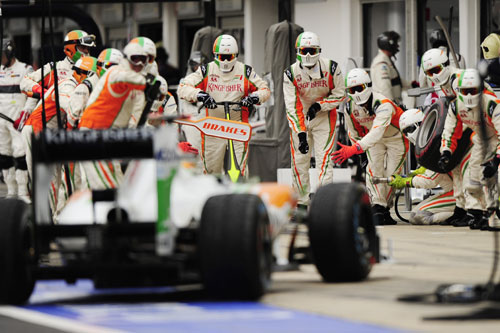|
saLT |
the-south-asian Life & Times Oct - Dec 2011 |
|
|||
|
Cover Story SALT
interviews
From
Battlefield to
|
|
||||
|
Formula One car – a jet
fighter on asphalt
Teams spend tens of millions of dollars on research
and development of Formula One car in the field each year. Most of the
technological progress in Formula One is centred on one area: aerodynamics.
The fundamental principle of Formula One aerodynamics is to create the
maximum amount of downforce for the minimal amount of drag. The most interesting innovation has been the
introduction of ‘moveable aerodynamics’. The driver is now able to make
limited adjustments to the front wing from the cockpit during a race. The
driver has the ability to fine tune many elements of the race car from
within the machine using the steering wheel, which can be used to change
gears, apply rev limiter, adjust fuel/air mix, change brake pressure, and
call the radio.
Driver fitness
Formula One drivers are perhaps the most hardened
athletes in terms of stamina and endurance. Their bodies have to adapt to
the exacting requirements of speeds reaching 370kmph and withstand the vast
loadings that Formula One cars are capable of creating, anything up to a
sustained 3.5 g of cornering force, for full race distances. Many drivers
use specially designed 'rigs' that enable them to specifically develop the
muscles in the neck and chest, to withstand cornering forces.
Fuel
The fuel used in F1 cars is fairly similar to
ordinary petrol, but with tight controls over the blends. Power-boosting
additives cannot be used. There are 50 different blends, tuned for the
demands of different circuits and different weather conditions. The FIA fuel
regulations are extremely stringent. Each fuel blend must be submitted to
the FIA prior to the race, for approval of its composition and physical
properties. A 'fingerprint' of the approved fuel is then compared to the
actual fuel being used at the event by the FIA's mobile testing laboratory.
Pit stops – A Perfect
Choreography A Pit stop is breath-taking in its speed and
efficiency. It is a carefully executed and orchestrated choreography. A
precisely timed pit stop is vital to a team’s success.
Tyre change, parts replacement, and wing adjustment happens in
seconds. Routine tyre stops can be over in well under five seconds. One
mechanic removes and refits the nut with a high-speed airgun, one removes
the old wheel, and one fits the new one! Other mechanics may make other
adjustments during the stop. The mechanics step back and raise their hands
as soon as their work is done.
Logistics – A War-Like
Troop Movement
To get all team equipment to the circuit – is a
mammoth logistics exercise – nothing short of troop movement in a military
campaign. Each team competing in the FIA Formula One World Championship
moves every couple of weeks to a new destination for races, and travels, on
the average, around 100,000 miles a year. Apart from transportation, hotel
accommodation (a team can require anything up to 100 rooms), secure data
links, and team’s facilities at the circuit need to be organised. For the
European races, most teams have their own transport vehicles that carry the
team equipment, which includes spare engines, spare chassis and many other
spares, apart from the usual load of cars and tools. But for
transcontinental races, equipment is flown out in cargo planes in specially
designed cargo crates.
Read the entire article in the print edition of The South Asian Life & Times subscribe@the-south-asian.com |
|||||
|
Copyright © 2000 - 2011 [the-south-asian.com]. Intellectual Property. All rights reserved. |
|||||
